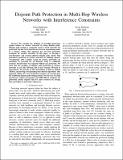Disjoint path protection in multi-hop wireless networks with interference constraints
Author(s)
Kuperman, Gregory; Modiano, Eytan H
Downloaddw_globecom_six copy.pdf (269.1Kb)
OPEN_ACCESS_POLICY
Open Access Policy
Creative Commons Attribution-Noncommercial-Share Alike
Terms of use
Metadata
Show full item recordAbstract
We consider the problem of providing protection against failures in wireless networks by using disjoint paths. Disjoint path routing is commonly used in wired networks for protection, but due to the interference between transmitting nodes in a wireless setting, this approach has not been previously examined for wireless networks. In this paper, we develop a non-disruptive and resource-efficient disjoint path scheme that guarantees protection in wireless networks by utilizing capacity "recapturing" after a failure. Using our scheme, protection can oftentimes be provided for all demands using no additional resources beyond what was required without any protection. We show that the problem of disjoint path protection in wireless networks is not only NP-hard, but in fact remains NP-hard to approximate. We provide an ILP formulation to find an optimal solution, and develop corresponding time-efficient algorithms. Our approach utilizes 87% less protection resources on average than the traditional disjoint path routing scheme. For the case of 2-hop interference, which corresponds to the IEEE 802.11 standard, our protection scheme requires only 8% more resources on average than providing no protection whatsoever.
Date issued
2015-02Department
Massachusetts Institute of Technology. Department of Aeronautics and Astronautics; Massachusetts Institute of Technology. Laboratory for Information and Decision SystemsJournal
2014 IEEE Global Communications Conference
Publisher
Institute of Electrical and Electronics Engineers (IEEE)
Citation
Kuperman, Greg, and Eytan Modiano. “Disjoint Path Protection in Multi-Hop Wireless Networks with Interference Constraints.” 2014 IEEE Global Communications Conference (December 2014), Austin, TX, USA, Institute of Electrical and Electronics Engineers (IEEE), 2014.
Version: Author's final manuscript
ISBN
978-1-4799-3512-3
ISSN
1930-529X